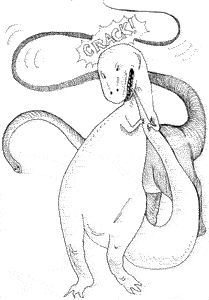Backlash: Dino tails lethal weapons

DRAWING BY DEBORAH DERR McCLINTOCK
Q. Speculating a little, what really weird thing might dinosaurs have done with their tails? –H. Hefner
A. It's not hard to imagine spiky tails used as weapons, or weighty tales used for balance during running or hopping, says R. McNeill Alexander in Dynamics of Dinosaurs & Other Extinct Giants.
But mull this: The long tapering tails of Diplodocus and Apatosaurus might have found application as formidable whips for striking an enemy predator. "Is it too wild a speculation to wonder whether Diplodocus could crack its tail?" Then flicked like a circus whip, its tip-end would race above the Jurassic plain supersonically, unloosing a miniature sonic boom.
Q. Can computers crack funny jokes? –G. Carlin
A. Computer whiz Kim Binsted created the program JAPE (Joke Analysis and Production Engine) for generating punning riddles– by the thousand! The program uses templates such as "What do you get if you cross an X with a Y?," and fills in from lexicon lists.
Most of these are duds, but a few are indistinguishable from jokes making the rounds. See if you can pick the two from JAPE and the two from Kaye Webb's Crack-a-Joke Book: 1. What do you call breakfast food that murders people? A cereal killer 2. What do you give a hurt lemon? Lemonade 3. What kind of tree can you wear? A fir coat 4. What runs around a forest making other animals yawn? A wild bore Answer: 1 and 3 are JAPE's japes.
Q. If the professional dance troupe "Out of This World" ever tours the colonized moon, what happens to leaps, turns, tapping in one-sixth Earth's gravity? Could the show get off the ground there? –N. Armstrong
A. Book them at the new Lunar Theater– the one with the very tall ceiling, because the same-leg strength for a two-foot, .7-second Earth jump will take a moon dancer 12 feet up and floating (atmospheric bubble) four full seconds, says Dickinson College physicist Kenneth L. Laws. Just imagine the tricks that might be performed before landing!
Pirouettes are tricky, since the lesser gravity reduces friction between feet and floor and saps spin torque force– about one-sixth for Earth dancers– making for some lazy turns. Think slow-motion choreography, with leapers seeming to soar in the air and take forever. Too long, maybe– the effect might be one of sluggishness, movement lost in time and space and music.
Toe-tapping and heel-slamming in the lax gravity will demand a lighter touch, or the dancer may simply be launched, adds University of Illinois physicist George Gollin. It will be tough to keep firmly planted on the floor, in control of movement and direction– no fast-feet Michael Flatleys there!
How to speed things up? More friction could help, says Laws: "So that's why the Lunar Theater stage has a ceiling 30 feet high and molasses on the floor!"
Q. Surprise: Sunshine actually has weight. How much? Is it good for anything? –G. Harrison
A. "Weight" is a slight misnomer because weight implies mass, and mass can't move at the speed of light (Einstein). But sunlight's speeding photons do exert a "radiation pressure," evident in space dust pushed backward from a comet and lighting up as the tail, away from the sun.
Figure this pressure at about .00000000048 lb./sq. in., for an incident solar power of 0.1 Watt/sq. cm. on a nonreflective surface. That's roughly a gram (1/454 lb.) of sunshine falling on an area the size of a soccer field, says Yale physicist Janet Pan.
Doesn't sound like much, but take it out into space, and its effects are far from theoretical, where one day solar pressure on large solar sails may propel humans to distant points in the cosmos. The gain of solar sails is they're lightweight, provide a sustained acceleration force with speed building, and there's no fuel to carry.
Traveling really light.
Send Strange questions to brothers Bill and Rich at .